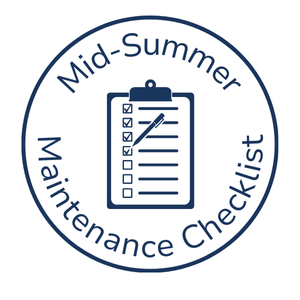As campuses prepare to welcome students back, facility managers face a pressing but often overlooked responsibility: ensuring water systems are safe and free of Legionella bacteria. With dormitories, classrooms, gyms, and cafeterias sitting idle or underused during summer, stagnant water becomes a breeding ground for Legionella bacteria, posing serious health risks to returning students and staff1,2,3.

Now is the time for proactive prevention. Here’s your mid-summer maintenance checklist to reduce the risk of Legionnaires’ disease outbreaks before doors open this fall.
1. Inspect the Entire Water System
Before any remediation work begins, conduct a comprehensive inspection of your facility’s water system. Focus areas include:- Domestic cold and hot water loops
- Water heaters and storage tanks
- Drinking fountains and bottle-filling stations
- Eyewash stations and science lab sinks
- Pools, spas, and decorative fountains
2. Flush All Fixtures
Flush dormant or low-use fixtures regularly, especially if the facility has been closed or only partially used since spring3.- Showers and Sinks: Run hot and cold water for at least 5 minutes.
- Exterior Faucets and Hose Bibbs: Don’t forget outdoor fixtures, especially those used for athletics or maintenance.
3. Test Water Quality
After flushing, test water samples for key parameters that influence Legionella bacteria growth1,3:- Temperature: Ensure hot water stays above 120°F (49°C) and cold water below 77°F (25°C).
- Chlorine Residuals: Confirm sufficient disinfectant levels.
- Legionella Presence: For higher-risk facilities like dorms or healthcare buildings, consider laboratory testing to detect Legionella pneumophila directly.

4. Review and Clean HVAC Systems
Cooling towers, air conditioning units, and evaporative condensers can aerosolize Legionella if not properly maintained. In advance of high summer loads and full occupancy:- Inspect and clean cooling towers, replacing any stagnant water.
- Disinfect condensate pans and drains.
- Check filters, ductwork, and humidifiers for mold and debris.
- Ensure proper water treatment chemicals are being applied.
5. Water Management Plan (WMP)
A Water Management Plan should outline your facility’s risk points and corrective actions. If you don’t already have one, now is the time to implement a CDC-compliant WMP1,3. If you do, update it with:- Findings from inspections and testing
- Maintenance logs and flushing schedules
- Any corrective actions taken
- Staff training records and roles
Don’t Wait, Act Before the Bell Rings
Legionella outbreaks can result in illness, lawsuits, and even temporary school closures. Proactive maintenance during July and early August can prevent costly emergencies and keep students safe as they return to campus life. If you need help creating or updating your water management plan, or require professional water testing and remediation services, reach out to our team. Let’s make this school year start safely.References
- Aw, T. G., Wengert, S., Hall, J. S., & Rose, J. B. (2022). Prevalence of opportunistic pathogens in a school building plumbing during periods of low water use and a transition to normal use. International Journal of Hygiene and Environmental Health, 241, 113945. https://doi.org/10.1016/j.ijheh.2022.113945
- Nielsen, N. S., Fojan, P., Jensen, R. L., Wahedi, H., & Afshari, A. (2024). Legionella in Primary School Hot Water Systems from Two Municipalities in the Danish Capital Region. Microorganisms, 12(10), 2074. https://doi.org/10.3390/microorganisms12102074
- Centers for Disease Control and Prevention (2024). Reopening Buildings Guidance “Building Water System: Control Legionella.” Accessed July 17, 2025. https://www.cdc.gov/control-legionella/php/guidance/building-water-system.html.



